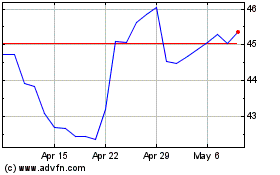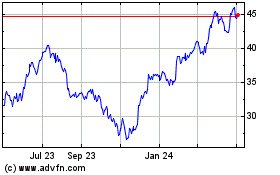By David Benoit and Mike Colias
Investor David Einhorn is pressing General Motors Co. to take
the novel step of creating two classes of common stock that would
separate its dividend from its operations, a proposal he says would
boost the auto maker's languishing stock.
Mr. Einhorn's Greenlight Capital Inc. wants the auto maker to
split its common stock into two classes: one that pays dividends
and a second that would entitle its holders to all earnings after
the dividend is paid.
Greenlight said the move could attract new investors who are
willing to pay more for potential earnings growth, boosting the
auto maker's market capitalization by as much as $38 billion. GM's
market value currently stands at around $52.2 billion, according to
data provider FactSet, and it currently pays an annual dividend of
$1.52 per share.
In a statement, GM said its board and management team "have
thoroughly analyzed and rejected" Einhorn's proposal.
GM said it discussed the plan with Greenlight several times over
the past seven months, including a meeting with GM directors. The
company said it consulted with credit-rating firms and banks before
determining the plan "creates an unacceptable level of risk,"
including the potential loss of its investment-grade credit rating,
which took GM years to restore following bankruptcy.
The company also cited "unknown and uncertain market demand and
liquidity" for the proposed shares, which could pressure the stock.
And it raised concern about the governance challenges that could
arise from having two classes of holders with competing
interests.
GM, the nation's largest auto maker, has benefited from a
seven-year rise in U.S. auto sales since the financial crisis,
while prolonged low gas prices have fueled demand for the company's
high-margin pickup trucks and SUVs. It posted $12.5 billion in
operating profit last year -- its second straight record -- with
the lion's share coming from North America, its primary truck
market.
Yet its shares have underperformed the broader market since the
company returned to the public markets in 2010 following a
government-sponsored trip through bankruptcy court in 2009. The
stock closed Monday at $34.71, up about 5% from its $33 initial
public offering price in November 2010.
The stock trades at the lowest valuation in the S&P 500,
measured by the price compared with its expected
earnings-per-share. Its dividend yield, meanwhile, is among the top
25 in the index.
Greenlight has been a GM investor at various points for about
five years and had a 0.9% stake and options on 25 million shares at
the end of December.
Mr. Einhorn, who also told GM he plans to nominate four
directors to its board, thinks the auto maker isn't getting credit
for either its earnings potential or its dividend payouts. He
believes GM's management is doing a good job operating the business
and isn't pushing it to change its capital spending plan, as other
investors have done in the past.
The hedge fund estimates the dividend stock could trade at
between $17 and $22 and the remaining stock from $26 to $28,
according to an investor presentation made public Tuesday. At those
levels, the stock gains could total between $12 billion and $38
billion.
GM said the proposal would "have no positive effect on GM's
underlying business or cash flows."
"The proposed dividend security would not help GM sell more
cars, drive higher profitability, or generate greater cash flow --
nor would it address the fundamental sector factors affecting GM's
stock price," the auto maker said.
Mr. Einhorn has made a career pushing what he sees as
misunderstood stories on Wall Street. He argued that Lehman
Brothers Holdings Inc. was overvalued months before its collapse.
He pushed Apple Inc. to issue a dividend-paying preferred stock as
a way to return more capital to shareholders, dubbing it "iPref."
The company rejected the proposal but later implemented a $100
billion capital return plan.
His campaign comes just two years after GM fended off a proxy
fight led by a group of hedge funds and Harry J. Wilson, an Obama
administration official who ushered GM through bankruptcy in
2009.
GM responded with a $5 billion stock buyback plan. It also
detailed to investors the return it expected on its own spending,
tying executive compensation to return on invested capital, a
favorite metric of hedge funds and other investors. GM said that
above a $20 billion cushion, it would return to shareholders any
cash that it couldn't put to work for at least a 20% return.
The moves persuaded the investors, a group that included
Appaloosa Management LP and Hayman Capital Management LP, to drop
their push to add Mr. Wilson to GM's board.
GM Chief Executive Mary Barra has said she believes the market
eventually will reward the company for its improving performance.
She has pressed for improved products and cut materials and
logistics costs while pursuing technologies that promise to reshape
car business, including its acquisition of autonomous-driving
startup Cruise Automation and a $500 million investment in
ride-hailing company Lyft.
Despite GM's healthy results in recent years, investors are
cautious as U.S. vehicle sales show signs of peaking. Analysts say
they want to see evidence that GM can remain solidly profitable in
the next market downturn.
GM has said it has positioned the business to remain profitable
even if U.S. industry sales fall below 11 million light vehicles
from the 17.5 million sold last year. Most forecasts show sales
remaining in the 16 million to 17 million range for the next
several years.
Write to David Benoit at david.benoit@wsj.com and Mike Colias at
Mike.Colias@wsj.com
(END) Dow Jones Newswires
March 28, 2017 13:54 ET (17:54 GMT)
Copyright (c) 2017 Dow Jones & Company, Inc.
General Motors (NYSE:GM)
Historical Stock Chart
From Mar 2024 to Apr 2024

General Motors (NYSE:GM)
Historical Stock Chart
From Apr 2023 to Apr 2024
